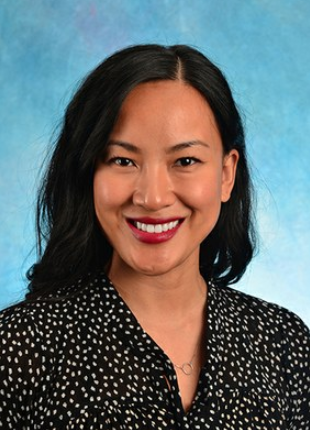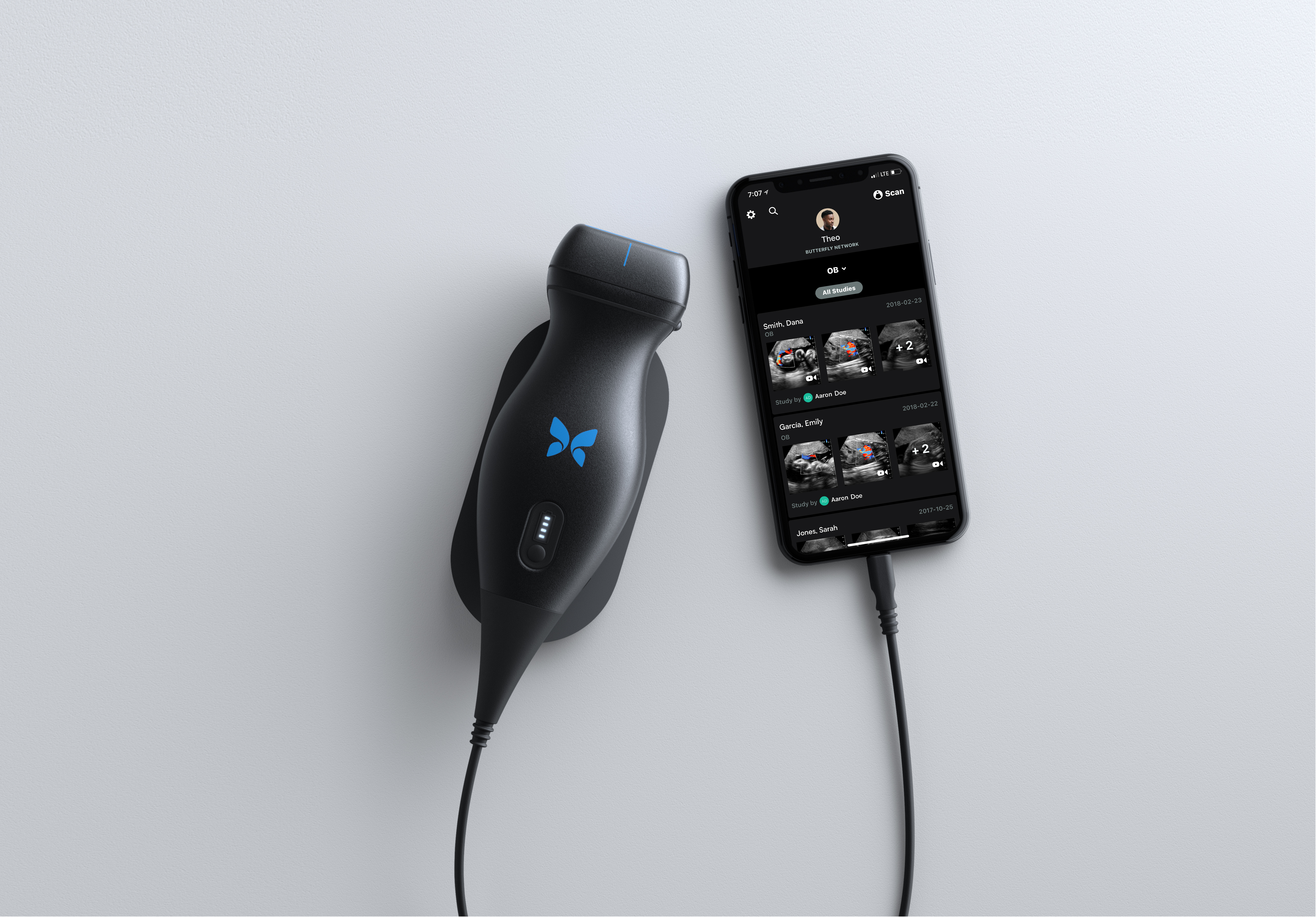
Department of medicine hospitalist Dr. Ria Dancel sees through critical windows in the human body using a portable, pocket-sized ultrasound device. A semiconductor-chip-based ultrasound probe plugs into her smartphone, and adjusts with a scroll of her finger to a high frequency, allowing high resolution imaging of blood vessels, skin infections, and joints. When she needs a view of a patient’s heart or abdominal organs, the probe switches to a lower frequency and increases depth.
More sensitive than X-rays, with no radiation exposure and no need to transport the patient to radiology, point-of-care ultrasound (POCUS) is a tool that enables physicians to observe an area of a patient’s body and support a rapid diagnosis. With development of more affordable technology, Dancel envisions ultrasound probes will soon be in the pockets of trainees everywhere.
“There is an important movement bringing physicians back to the bedside to strengthen the patient-physician relationship and bringing ultrasound to the bedside as a tool can greatly enhance our physical diagnostic skills,” said Dancel, associate professor of internal and pediatric medicine and director of the medicine procedure service.

“Point-of-care ultrasound has the added benefit of making bedside diagnosis a shared experience with our patients. While they may not be able to appreciate what we are auscultating, palpating, or percussing, patients become immediately engaged when I show them what I am seeing on ultrasound.”
Interest in goal-directed ultrasound examinations, performed by a healthcare provider to answer a specific question, or guide performance of an invasive procedure at the bedside, is rapidly advancing. In acute settings, critical decisions can be made more quickly, shortening the time to treatment, and if a complication can be prevented, or care expedited, a patient has the chance to heal more quickly, not to mention saving healthcare costs over time.
POCUS Can Enhance the Physical Exam
Dancel recognizes that the best hands to hold the ultrasound probe are those of the questioning physician, one whose training in physiology, disease processes, and practical medicine can appreciate the nuances of point-of-care ultrasound.
“Two-thirds of North Carolinians are overweight or obese, and having patients who are unable to cooperate or can’t physically participate, can impede physical exams. Plus, there are intrinsic issues in physician skills to consider as the ability to percuss, palpate, and auscultate changes with age. Degradation of tactile and auditory acuity is subtle, and may not even register, for many physicians. Point-of-care ultrasound augments the physical exam.”
As a nationally recognized expert, Dancel leads workshops, teaches essentials in critical care ultrasound at the American College of Chest Physicians headquarters, and helped create Society of Hospital Medicine’s certificate of completion in POCUS for other hospitalists. She recalls the moment she knew she wanted to pursue POCUS.

“I was seeing a patient in the ED with abdominal pain and distention. I was concerned that there may have been infected fluid in his abdomen but I couldn’t tell from my physical exam how much fluid was there and if sampling the fluid would be safe,” says Dancel in her Medicine Grand Rounds lecture. “I used an ultrasound to look for the fluid (called ascites). Instead, I saw a gray dense structure moving into the pelvis, every time the patient breathed. It turned out that my patient had enlarged abdominal organs and very little ascites. POCUS saved this patient from a risky procedure.”
Two Papers in the Journal of Hospital Medicine (JHM).
Credentialing of Hospitalists in Ultrasound-Guided Bedside Procedures: A Position Statement of the Society of Hospital Medicine, provides a framework for credentialing hospitalists in performing procedures, in particular for hospital medicine groups that are just starting to create a procedure service. The statement emphasizes how ultrasound guidance is increasingly essential to six bedside procedures that are core competencies of hospitalists: abdominal paracentesis, arterial catheter placement, arthrocentesis, central venous catheter placement, lumbar puncture, and thoracentesis. The JHM statement can be found here.
Dancel is the first author on the second paper in the series, Recommendations on the Use of Ultrasound Guidance for Adult Thoracentesis, which will soon be followed by a paracentesis guideline.
“These guidelines are necessary because, as of yet, ultrasound guidance has not been widely accepted as “standard of care” for most bedside procedures. Yet, ultrasound guidance has been shown to decrease complications for nearly all bedside procedures. The most work has been done on real-time ultrasound guidance for central venous catheterization, which has been shown to decrease central line associated bloodstream infections and is endorsed by the CDC.”
In 2010, the British Thoracic Society recommended ultrasound guidance for pleural procedures, but this was before SHM’s position statement was published in the JHM, before there was a guiding document for general internists performing bedside thoracentesis. After a systematic review, Dancel says evidence shows that ultrasound guidance decreases the most common complication of thoracentesis, pneumothorax. It also increases the procedure’s success and allows hospital medicine to appropriately refer cases to interventional pulmonology, based on the appearance of pleural effusion on ultrasound. The JHM article can be accessed here.
UNC’s Medicine Procedure service, created nearly five years ago, is comprised of physicians, highly skilled in using bedside ultrasound for diagnosis, who provide guidance on procedures such as paracentesis, thoracentesis, central line placement, and lumbar punctures. To ensure ongoing competency, approximately 10 hospitalists supervise on the procedure service at UNC and must be on service at least 5 weeks a year to maintain competency. Dancel personally trains new proceduralists before they attend on the medicine procedure service.
The Next Step in the Evolution of Internists
Dancel believes the next step in the evolution of internists will be to appropriately and proficiently use POCUS to guide diagnosis.
“It was a logical next step in my growth,” Dancel said. “Many times, I was asked to perform a procedure on a patient and found, using POCUS, that the cause of their symptom was not what we expected. For example, instead of seeing a pleural effusion in a patient with hypoxia, I saw lung consolidation suggesting pneumonia. Instead of a procedure, the patient needed antibiotics. Or, I saw masses on the diaphragm that guided our next steps in a malignancy workup. Or, I saw a large pericardial effusion that needed to be drained emergently before a thoracentesis would be appropriate.”
After completing a certificate of completion in critical care ultrasound from CHEST in 2015, Dancel began teaching POCUS at UNC and nationally. Her immediate goal is to develop a group of POCUS competent faculty and resident leaders in the department of medicine, followed by a robust curriculum for the rest of the residency program.